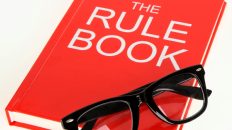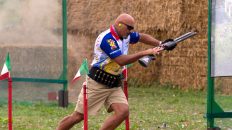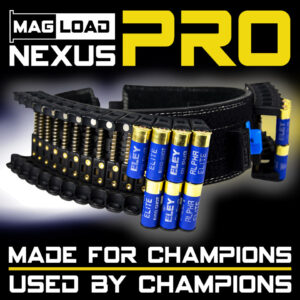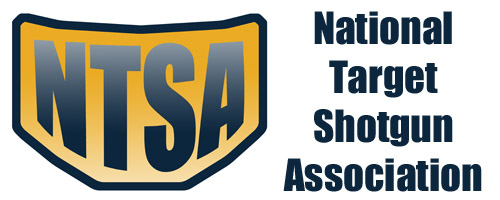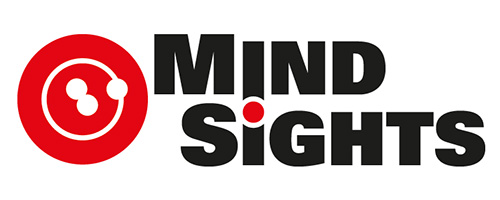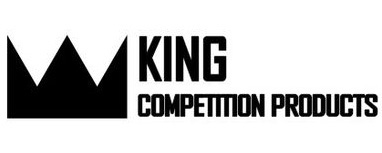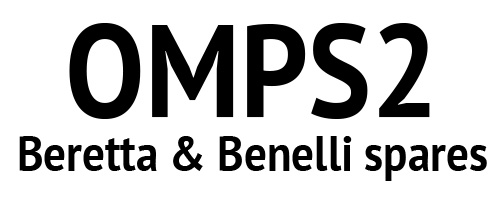Competitors have a right under the current IPSC rules to ask for calibration if a metal target does not fall. This may change in future rule versions to apply only to poppers and exclude plates, the rule is currently being debated by the powers that be, but it currently applies to all metal targets. The relevant section from the rule book describes the process in detail there are a few simple considerations:
If you shoot a second (or third or forth…) shot and the target falls you have lost your opportunity to ask for calibration – the target must be standing after you finish the stage if you want to ask for calibration.
The basic principle for a birdshot stage is that all targets can be knocked over with an open choked 12 gauge shotgun firing standard birdshot ammo – if there are penalty targets in the array then the scoring targets must be possible without getting a penalty.
If you ask for calibration then the stage is stopped until the calibration officer comes with the calibration gun and the calibration ammo…. and the process detailed under section 8 below will begin.
If you are at a well organised match the targets will have been tested, the calibration officer will be a very good shot and you will be very lucky indeed if this gets you a re-shoot HOWEVER if you look at the target array and feel pretty sure that it cannot be done without hitting penalty targets using an open choked gun then it is within your rights as a competitor to ask for calibration up to 3 times at a match with up to 15 stages and 4 times at a bigger match.
APPENDIX C1: Target Calibration and Testing
1. The Range Master must designate a specific supply of ammunition and one or more firearms to be used as official calibration tools by officials authorized by him to serve as testing officers.2. The manufacturer’s data for the test ammunition will be assumed to be accurate and will not be subject to any protest.
3. Once the supply of ammunition and the designated firearm have been approved by the Range Master, they are not subject to challenge by competitors.
4. The Range Master must make arrangements prior to the commencement of a match so as to be satisfied that all metal targets will fall, and frangible targets will break, when properly hit and he will determine which of these targets he considers necessary to be tested. Testing is only likely to be necessary on longer distance targets or for targets that are in the close proximity to no-shoots. In the former case to ascertain that they will fall, or break, when properly hit and in the latter to confirm that it is indeed possible to successfully shoot the scoring target without incurring a penalty because of the pattern spread of the shot (birdshot and buckshot ammunition).
5. The Range Master must make arrangements prior to the commencement of a match so as to be satisfied that any paper targets or frangible targets in close proximity to any no-shoot can be successfully shot when required without incurring a penalty because of the pattern spread of the shot. He will determine which of these targets he considers necessary to be tested.
6. Unobstructed metal targets must be set to fall when adequately hit within the calibration zone from a designated firearm using the calibration ammunition. Calibration zones for poppers are indicated in the diagrams in the following pages. The calibration or test zone for other unobstructed metal targets is the centre of the target. The testing officers, in consultation with the Range Master if considered necessary, will determine whether each test shot results in an adequate hit and is subject to the following points:
(a) It may be that not all of the shot pattern hits the target but the centre of the pattern should approximately strike the centre of the zones described above.
(b) If the target does not fall when properly hit, it must be re-calibrated/re-tested, if necessary the target must be moved until a successful test is accomplished.
(c) All testing, including testing as provided for in 8(c) below, is to be conducted from the closest and easiest point (directly up range) from where a competitor could engage the target.7. Prior to the commencement of a match for any target that is in close proximity to no-shoots a test shot should be fired to determine that the target can be successfully shot for score without incurring penalty. If, in the opinion of the testing official, a failed attempt was as a result of poor marksmanship or insufficient allowance for the spread of shot then 2 additional shots must be fired, both of which must be successful else the target, or the no- shoot must be moved until a successful test is accomplished.
8. If, during a course of fire, a metal target does not fall when hit, a competitor has three alternatives:
(a) The target is shot again until it falls. In this case, no further action is required and the course of fire is scored “as shot”.
(b) The target is left standing but the competitor does not request the target to be tested. In this case, no further action is required and the course of fire is scored “as shot”, with the subject target scored as a miss.
(c) The target is left standing and the competitor requests the target to be tested. In this case, the target and the surrounding area on which it stands must not be touched or interfered with by any person. If a Match Official violates this rule, the competitor must re-shoot the course of fire. If the competitor or any other person violates this rule, the target will be scored as a miss and the rest of the course of fire will be scored “as shot”. A competitor is permitted a maximum of 3 requests for testing during a match of up to (and including) 15 stages and to a maximum of 4 requests for testing during a match of over 15 stages.
(d) If the popper falls for any other reason (e.g. wind action), before it can be calibrated, a reshoot must be ordered.
IPSC Shotgun Rules, January 2017 Edition 539. When testing is requested under 8(c) above, the testing officer will visually inspect the target for obstructions that may have prevented proper operation. Then, if no obstruction is found the following will apply:
(a) If the first shot fired by the testing officer hits the calibration zone of a metal target, or below, and the target falls, the target is deemed to be properly calibrated, and it will be scored as a miss.
(b) If the first shot fired by the testing officer adequately hits the calibration zone of a metal target (see also (d) below) and the target does not fall, the target is deemed to have failed, and the competitor must be ordered to re-shoot the course of fire, once the target has been recalibrated.
(c) If the first shot fired by the testing officer adequately hits below the calibration zone of a metal target and the target does not fall, the calibration test is deemed to have failed, and the competitor must be ordered to re-shoot the course of fire.
(d) For targets in close proximity to no-shoots and where it is not possible to centre the pattern of the shot without incurring a penalty, the testing officer will determine whether the test shot resulted in an adequate hit. The testing officer’s decision cannot be protested.
(e) If the first shot fired by the testing officer misses the target altogether, another shot must be fired until either 9(a), 9(b), 9(c) or 9(d) occurs.Test Gun Specification:
Caliber: 12 gauge.
Maximum barrel length – 66 cms. True cylinder or open choked barrel. Any action type.Test Cartridge Specification:
All ammunition used in a match is required to conform to a minimum PF of 480 and it is the competitor’s responsibility to choose appropriate cartridges. However, for calibration and testing purposes the cartridge specifications below will apply.
In the absence of there being a readily available supply of cartridges that conform to the test specifications then hand loaded cartridges that meet the required specifications should be used. In exceptional circumstances other factory produced cartridges closest to the required specifications may be used but must be clearly stated on all match literature in accordance with Rule 5.8.3.For Birdshot Courses of Fire
Diameter of shot to be between 2.54 mm (0.10 inch) – 2.28 mm (0.09 inch). Maximum total weight of shot (pellets): 28.3 grams (1 ounce).
The manufacturer’s stated velocity is to be less than 1300 fps.
(This equates to a maximum PF of 568).
See Rule 5.8.3.For Buckshot Courses of Fire
Buckshot: OO or local equivalent.
Max of 9 pellets per cartridge.
Manufacturers stated velocity to be between 1350 – 1120 fps (lower velocities in the permitted range are preferred for testing).
(This equates to a PF of 584 – 484 with 28 gram loads).For Slug Courses of Fire
Max weight of slug 28.3 grams (1 ounce).
Maximum power factor to be less than 590 as calculated from manufacturer’s stated data. (A PF of around 520 or less is preferred).



